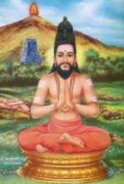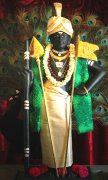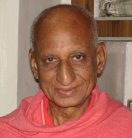

THE ESOTERIC
KANDAR ANUBHUTI
OR
THE SECRET TEACHING ON
GOD-EXPERIENCE
(A Treatise on Adwaitic Realization)
OF
SAINT ARUNAGIRINATHAR

 |  THE ESOTERIC KANDAR ANUBHUTI OR THE SECRET TEACHING ON GOD-EXPERIENCE (A Treatise on Adwaitic Realization) OF SAINT ARUNAGIRINATHAR |  |
 | by N.V. Karthikeyan |  |
| verses contents 13 14 15 16 17 18 19 20 21 22 .. 28 this verse in PDF version (4 parts) p-1 p-2 p-3 p-4 complete download of this book |
VERSE-18 உதியா மரியா உணரா மறவா விதிமால் அறியா விமலன் புதல்வா அதிகா அநகா அபயா அமரா வதிகாவல சூர பயங்கரனே.Uthiyaa mariyaa unaraa maravaa, Vithimaal ariyaa vimalan puthalvaa Adhikaa anakaa abhayaa amaraa Vathi kaavala soora bhayankarane. Unborn and deathless, non-thinking and non-forgetting, Commentary This is a very unique verse in the entire work of Kandar Anubhuti. It is just description of the Lord and His glory. There is no prayer for help, no lamenting over one's helpless condition, no supplication, no instruction, no admonition, no revelation of Grace, no description of spiritual experience, etc., etc. Though the verse looks simple, just descriptions of the Lords, it has deep esoteric meaning, philosophical import and spiritual significance. In the previous verse the seeker was asked to be firmly united with (rooted in) Reality and was also given the method, viz. intensifying Japa, singing the Lord's Names, etc. This is the method of Bhakti or devotion. Now in this verse the method of practice according to Jnana or philosophical-cum-spiritual point of view is given. As we have been seeing, throughout the Kandar Anubhuti Bhakti and Jnana go hand and hand. 'Firmly be united with Reality.' What is Reality and where is it to be united with? It was explained in the previous verse that Satchidananda is the Reality behind all objects or names and forms. That Satchidananda or Reality has two aspects, the Transcendental and the Immanent. As the Infinite, all-pervading and transcendental Reality it is called Brahman; and as the inner-most substance or Immanent Reality in all individuals and objects it is called the Atman or Self. Brahman and Atman are not two different entities, but only two viewpoints -- the Transcendental and Immanent aspects of One and the same Reality, going by two names. Thus, the Atman is Brahman; 'Ayam Atma Brahma' is the Mahavakya declaration of the Mandukya Upanishad. This truth is brought out in this verse so dexterously by saint Arunagiri, by describing Lord Siva with the attributes of Brahman (as birthless, decayless, etc. etc.) and Lord Skanda as His Son almost having the same attributes (Who was also described as 'Piravaan Iravaan', birthless and deathless, in verse-12) as "the Supreme, the Sinless One, the giver of refuge, the protector of Amaravati (Svarga or Devaloka), the terror to Surapadma!" The description of the Lord (though of Siva) in the first two lines as 'birthless and deathless', etc. are also those of Brahman, the Absolute. That Lord's son is Lord Muruga or Guhan who is also described as 'without birth and death' in verse-12. And we also know that Guhan is Siva Himself manifest in another form, for the purpose of destroying the Asuras. Thus Guhan and Siva are one. Guhan means 'the Indweller of the Heart' i.e. the Self or Atman; and Siva is Brahman. Thus, Arunagiri hints at the Mahavakya 'The Atman is Brahman -- Ayam Atma Brahma, which is one of the four Mahavakyas. Atman and Brahman are the same, they are the Immanent (individual) and Transcendental (Cosmic) aspects, respectively, of the Ultimate Reality. And meditation on the Atman or Self is the way to destroy Avidya or Ignorance, which is Surapadma. So Arunagiri refers to Guhan as 'Sura Bhayankaran' -- terror to Surapadma, because when meditation on the Self is started in all earnestness it sends a terror-signal to Avidya (Surapadma) and creates terror in him. He is not killed immediately, hence the Lord is referred to as 'Sura Bhayankaran' and not 'Sura destroyer' as mentioned in other verses. Killing of Sura or Avidya takes place after a long war, for which Sura will soon get prepared and start waging; Avidya will start creating havoc with the seeker, which we will see in the coming verses. After protracted war, Sura (Avidya) is killed by prolonged meditation on the Vel (Jnana) in Samadhi-Experience (verse-42). Thus, Arunagiri the master psychologist esoterically brings the Mahavakya 'Ayam Atma Brahma' in this verse so imperceptibly for the purpose of meditation on the Self. Thus, the verse points to a transition in the method of Sadhana from the religious and devotional aspect to the philosophical and spiritual side of Sadhana, i.e. meditation on the Self or Atman. A clue to real meditation is given in the verse. The first two lines describe the nature of Brahman-Atman and the last two lines indicate the method of meditation on the Self or Atman which will create terror to Avidya (Surapadman). Thus with the Knowledge given by the Lord (previous verse) i.e., leaving the delusion regarding the world he should be united with Reality (or the Self), the seeker commenced his meditation on the Satchidananda nature of the Lord, as the Self within. After a prolonged practice of meditation, he is able to fix his mind on the Self. It is pure contemplation and meditation (Dharana and Dhyana) on the Self or the Lord with attributes (Saguna Dhyana), which has awakened Avidya, referred to as 'terror to Surapadma'. God is birthless and deathless. He has neither a beginning nor an end. Everything has come from Him, is sustained in and by Him, and everything returns to or is absorbed into Him. But He, by Himself, knows no change. He does not think or forget, for there is nothing second to Him. Such is Lord Siva whose greatness is not known even to Brahma and Vishnu. There is a legend about it. Once, Brahma and Vishnu had a debate wherein each attributed Supreme Lordship to himself, but they could not decide the matter. Finally, finding no other means, they decided to settle the issue by a fight -- He who would win was to be regarded as the Supreme. The fight began and went on for several years and there seemed to be no end to it. Now Siva, wanting to put an end to their fight, appeared before them as a huge column of Light which flabbergasted them. Curious to know what it is, they stopped their fight. Then a voice was heard, "Why do you vainly quarrel over your superiority? Lord Siva only knows your strength. He who finds either the origin (bottom) or summit of this Light is the Supreme Lord." At once, Vishnu, assuming the form of a huge boar, went digging into the earth to find the bottom; and Brahma, taking the form of a huge swan, soared high in the skies to see the top of the Light. The more they searched, the farther was the Light seen! They were exhausted and failed in their attempts. At once the Light appeared as Lord Siva before them, seeing Whom their ego vanished and they stood accepting Siva as the Supreme Lord. Lord Siva again disappeared and only the huge column of Light was there, which gradually condensed itself into a mountain. This is the Arunachala Mountain at Tiruvannamalai. This is said to have happened on a Mahasivaratri day. Lord Siva had given boons to Surapadma and the Asuras, and so He could not kill them in that form of His; nor anyone else could kill them. Hence, Siva Himself appeared as Skanda to put an end to the Asuras. Thus, Lord Siva and Lord Skanda are one. To emphasise this it is mentioned in the verse that Lord Skanda is the spiritual son of the ever-pure One - Lord Siva. Lord Skanda is described as the Great One, He is the Sinless One and He destroys the sins of His devotees. He gives refuge to those who take shelter under His feet, who think of Him with an undivided mind. Lord Skanda is the protector of Amaravati, as He protected the Devas by killing Surapadman. He protected the Devas and destroyed the Asuras - this means He protects those who have Daivi Sampatti or divine qualities (seekers) and destroys those who are of Asuric nature (evil tendencies). The Lord is the protector of the good and destroyer of the unrighteous. Now, how to meditate on the Self is stated in the latter half. "The Great, the sinless, the Fearless, the Lord of the heart, and the terror to the ego," - thus, is the Self to be meditated upon. There is nothing greater than the Self or Atman. While the mind is greater than the senses, the intellect is greater than the mind, and greater than the intellect is the Atman, there is nothing greater to it. The Self is the "Sinless Ether" in the heart, says the Maha-Narayana Upanishad. It is Fearless, and out of fear for it the other faculties in us work harmoniously. The Self is the Lord (caretaker) of the heart (Amaravathi). The gods are the senses and just as gods dwell in heaven, whose capital is Amaravathi, the senses reside in this body whose center (or capital) is the heart. The mighty power of Skanda was a terror to Surapadman; even so meditation on the universal nature of the Self is a death-blow to individuality or Avidya. Thus, is shown the way of meditation on the Self as the 'Great and Sinless, as the Fearless, as the Support of the virtues and the destroyer of the vices in the Sadhaka, as the great terror to Avidya.' |
| contents 13 14 15 16 17 18 19 20 21 22 .. 28 this verse in PDF version (4 parts) p-1 p-2 p-3 p-4 |
| ... www.kaumaram.com ... The website for Lord Murugan and His Devotees முகப்பு கௌமாரம் அட்டவணை மேலே தேடல் home Kaumaram contents top search |
Kaumaram.com is a non-commercial website. This website is a dedication of Love for Lord Murugan. Please take note that Kaumaram.com DOES NOT solicit any funding, DIRECTLY or INDIRECTLY. |